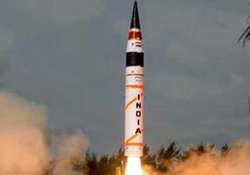India can produce 10,000 km range ballistic missiles: DRDO
New Delhi: Inter-continental ballistic missile Agni-5, which can cover entire China and reach Europe with its range of 5,000 km, will be ready for induction in the armed forces in two years, amid assertion by

New Delhi: Inter-continental ballistic missile Agni-5, which can cover entire China and reach Europe with its range of 5,000 km, will be ready for induction in the armed forces in two years, amid assertion by DRDO that it can produce a weapon system with a range of 10,000 km.
Addressing a press conference, DRDO Chief Avinash Chander said all the ballistic missiles in country's arsenal would be canistered to reduce the reaction time, in case of a nuclear attack.
He said by the end of this year or the beginning of the next year, the country's first indigenously-developed nuclear submarine INS Arihant would be carrying out weapon trials as part of its tests towards its induction in the Navy.
"Yes... actually range is least problematic part of the missile. We have full capability to go to any range. If we need a particular range, we can achieve that in two or two-and-a-half years. The issue today is more with the accuracy of the missiles," Chander said.
The DRDO chief was asked if the premier research organisation would be able to provide 10,000 km range missiles if government gives a go ahead to it.
Commenting on the Agni-5 missile, which was successfully testfired yesterday for the second time, he said, "The missile would be ready for induction in armed forces in the next couple of years after three to four more successful test-firings from canisters."
He said the Agni-5 along with all other ballistic missiles would be canistered which will help in reducing the response time in case of a nuclear attack.
"It (the response time) will be in order of few minutes from stop to launch and it will be very short. I cannot give you the exact time," Chander said.
India has a 'no-first use' policy for nuclear weapons which means that it needs to have a strong and quick response capability to reply in case of a strike by an adversary.
Addressing a press conference, DRDO Chief Avinash Chander said all the ballistic missiles in country's arsenal would be canistered to reduce the reaction time, in case of a nuclear attack.
He said by the end of this year or the beginning of the next year, the country's first indigenously-developed nuclear submarine INS Arihant would be carrying out weapon trials as part of its tests towards its induction in the Navy.
"Yes... actually range is least problematic part of the missile. We have full capability to go to any range. If we need a particular range, we can achieve that in two or two-and-a-half years. The issue today is more with the accuracy of the missiles," Chander said.
The DRDO chief was asked if the premier research organisation would be able to provide 10,000 km range missiles if government gives a go ahead to it.
Commenting on the Agni-5 missile, which was successfully testfired yesterday for the second time, he said, "The missile would be ready for induction in armed forces in the next couple of years after three to four more successful test-firings from canisters."
He said the Agni-5 along with all other ballistic missiles would be canistered which will help in reducing the response time in case of a nuclear attack.
"It (the response time) will be in order of few minutes from stop to launch and it will be very short. I cannot give you the exact time," Chander said.
India has a 'no-first use' policy for nuclear weapons which means that it needs to have a strong and quick response capability to reply in case of a strike by an adversary.